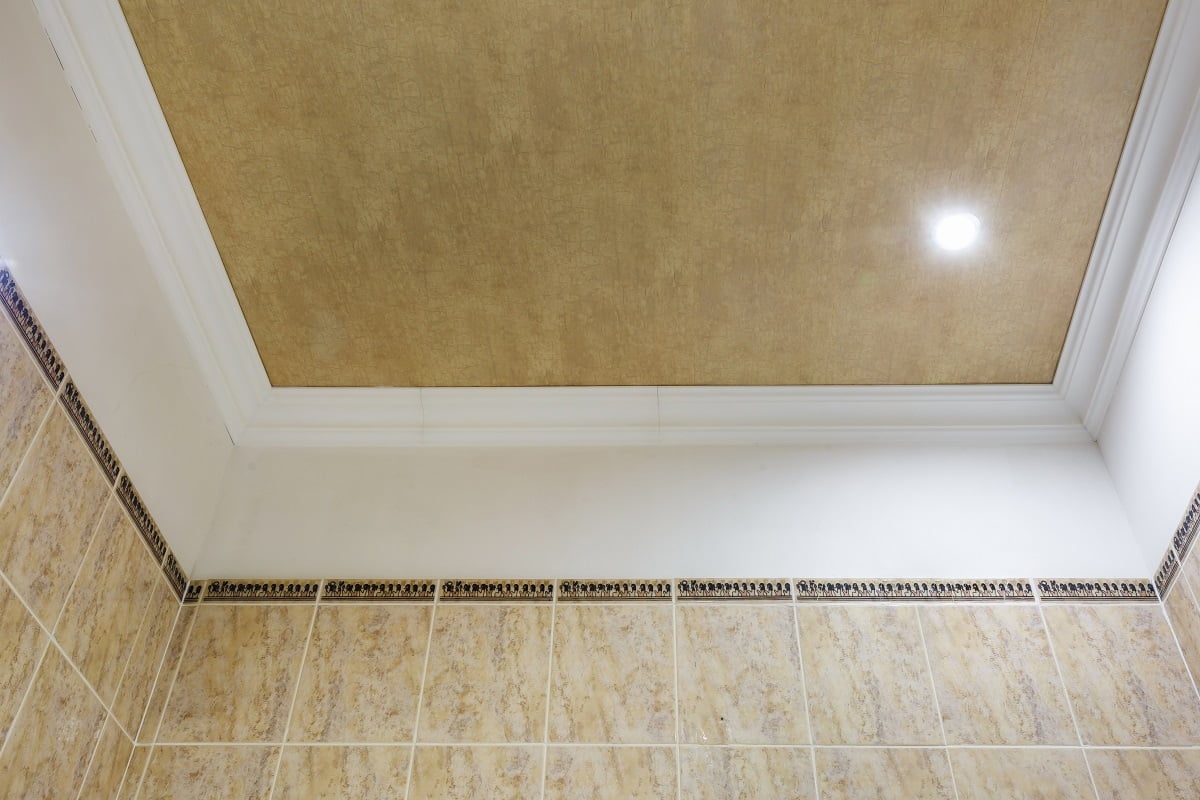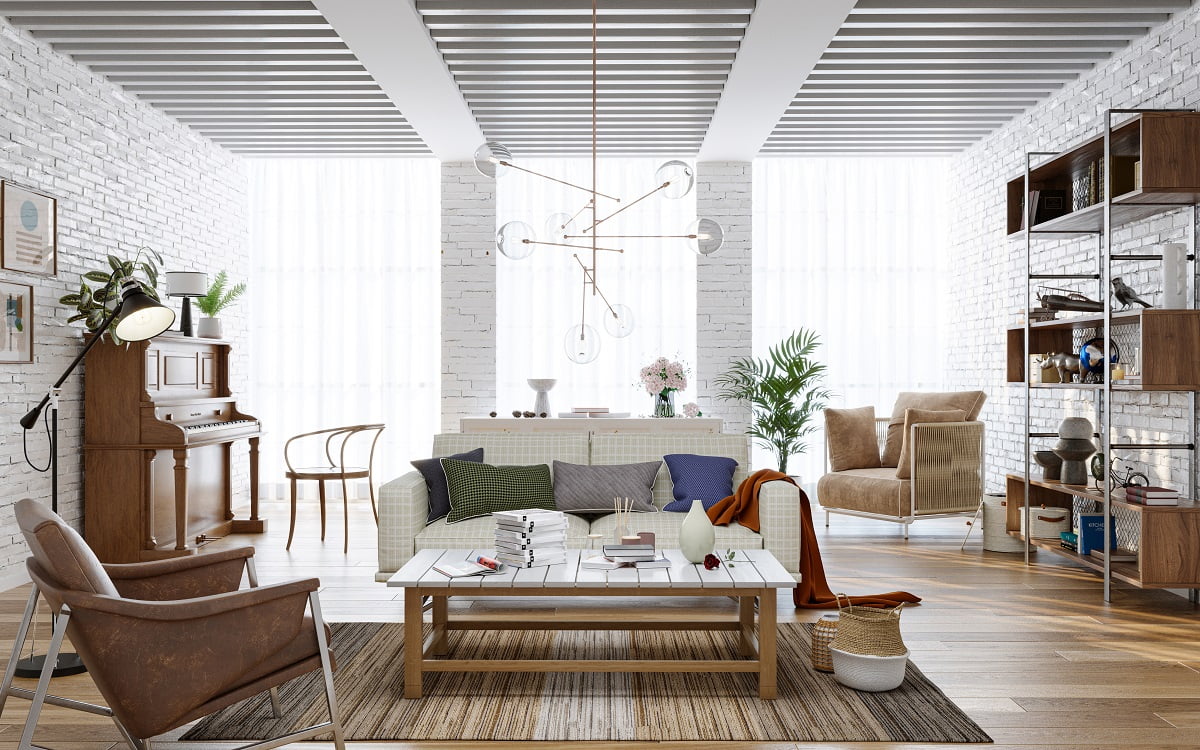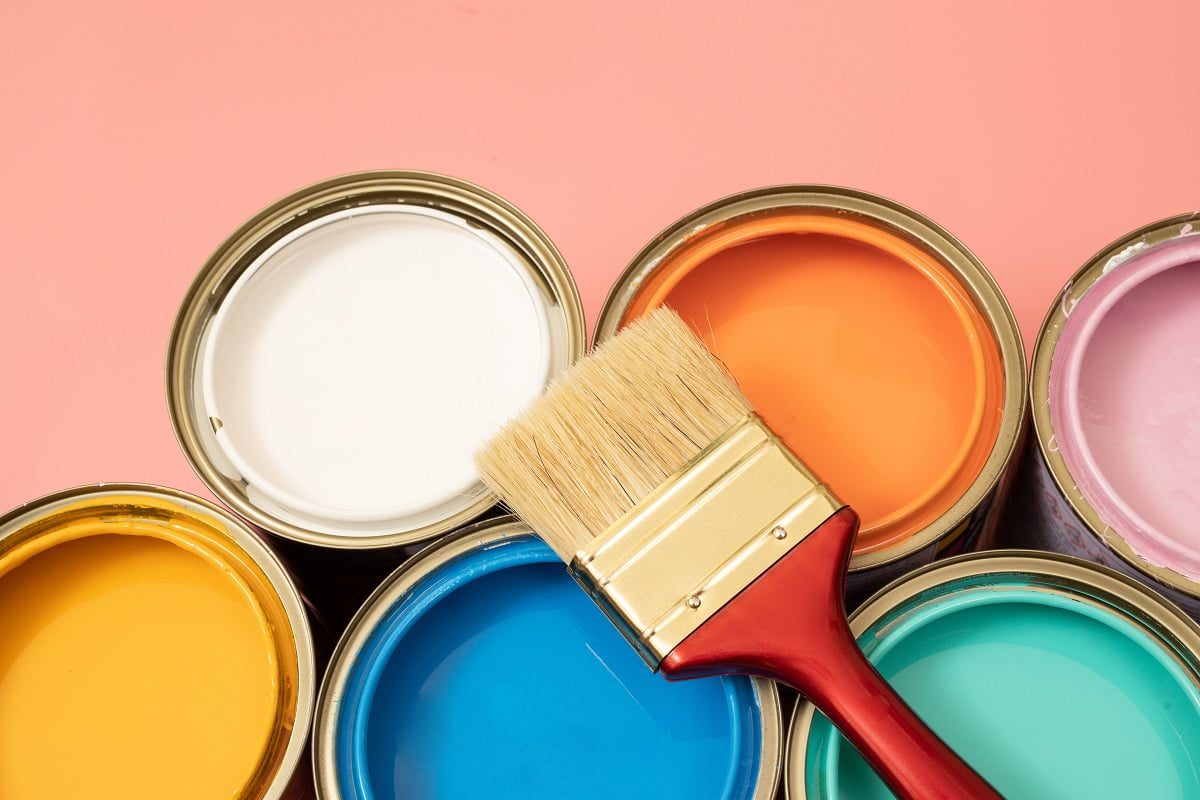Probably the best way to brighten up a room is by applying a refreshing coat of paint on the ceiling.

If you have textured ceilings, the first thing to determine is whether it needs a coat of paint at all. If yes, you'll need to look at the types of ceiling paint available and which ones would suit your textured ceiling. After selecting the ceiling paint, here comes the biggest part—the process of applying the paint.
And, this is where it gets challenging because not everyone knows how to paint a ceiling. Also, there are other aspects like discovering ceiling finish types and deciding the best ceiling paint for your home. But, before we get into details like how many coats of paint are required, let's find out if you need ceiling paint in the first place.
Is It Necessary To Paint Newly Textured Ceilings?

One may assume that a newly textured ceiling is good as it is, and paint must be added only if a change in color is required. However, it is generally accepted that adding a few coats of paint is a must for textured or popcorn ceilings.
Considering the drywall textured ceilings are made of a soft compound, the layer is susceptible to damage with regular activities like cleaning. It means, the moment you try to wipe the popcorn ceiling with a wet rag, it will come off. Besides, textured surfaces look more unfinished without a coat of paint as compared to flat ceilings.
Before painting the ceiling, it might be a better idea to prime it entirely for a smooth finish. For best results, PVA (polyvinyl acetate) primers are used to prime ceilings before adding a fresh coat of paint. Priming the surface seals the textured walls in and allows it to retain its look for a long time.
The bottom line is that you definitely need to paint a popcorn ceiling to retain its texture. The next logical step is to select the best ceiling paint for textured ceilings, which we will discuss in the next section.
Considerations For Applying Paint On Ceilings
1. Paint Color
There are no prizes for guessing which color is the most popular for applying over ceilings. That's right! White ceiling paint is preferred over all other colors for the simple reason that it makes the entire room look fresh and bright. The same is true for popcorn ceilings, with the only difference being that any color on a textured surface will not look as reflective as white.
Flat white ceiling paints do not reflect as much and can be used on all textured surfaces if that's the look you are going for. Otherwise, it is always possible to make custom colors by mixing the required tint in the white paint. You can use the same color as applied on the walls to create a cohesive effect in the room.
2. Type Of Finish
Apart from ceiling texture and color, you should also decide the kind of finish you'd like to see on the entire ceiling. The two popular types are flat and satin, in which flat paints are non-reflective while satin ones are shiny. People often use satin finish paints for the walls and continue with the same paint for the ceilings as well.
On the other hand, using a flat finish is the safest option for most ceilings because it does not draw much attention.
3. Number Of Coats Required
In most cases, one coat of primer should be enough for sealing after adding texture, but at least two coats of paint should follow. Some superior quality paints need a single coat, but those options can get expensive to apply over the entire ceiling.
Also, some companies sell paints mixed with primer claiming that one coat of paint plus primer is all you'll need to apply. Although we agree that painting a ceiling is tough work, there should always be a separate layer of primer and at least one coat of paint.
What's The Best Paint For Textured Ceilings?
Every company makes its own unique blend of paints for various ceiling finish types. Some paints are multi-purpose and can be used for any surface including the walls, while other blends are specifically for ceilings.
If you buy ceiling paints from a local store, chances are they will sell flat paints that stick well to primed surfaces. This option should be good enough if you're painting the entire room and need a fresh-looking space within a budget. However, specialized paints are available in bigger stores, but they will cost much more than your average tub.
Applying Paint On A Textured Ceiling
We will explain the detailed steps of applying paint, but we just wanted to quickly point out that tools are as important as paint. Painting on ceilings needs the most careful application; otherwise, the result might look shabby.
This is why it is essential to buy a good quality roller brush that is wide enough to cover a sizable portion at a time.
Types Of Ceiling Textures
Smooth ceilings are easy to paint, but textures like orange peel, popcorn, swirl, knock-down, and Santa-Fe skip trowel require decent application technique. The best coverage style is to get done with the corners first and then apply a thick layer on the center.
The Right Painting Direction
Most rooms have flat ceilings, so you simply have to move from left to right or vice versa to finish the painting. However, keep the direction of the painting consistent so that the final paint job looks cohesive. Submerge the roller in paint and apply in long strokes in one direction to prevent lap marks.
Also, make sure to take out some time to finish a large room because painting ceilings require upwards motions which are tiring to the arms.

How to Paint A Textured Ceiling
Now that we've covered the basics, it's time to learn how to paint a ceiling, especially a textured one.
How Much Paint Is Enough?
If you can calculate the amount of paint required in total, you can buy the exact number of tubs so that nothing goes to waste. Keep in mind that textured ceilings can utilize more paint as compared to regular ones since they have a higher surface area.
Generally, 400 to 500 square feet flat ceilings require one gallon of paint, textured ceilings will require double that amount.
Materials Required
1. Paint
We've already discussed in great detail the type of paint you can buy. If you want to keep things simple, go for flat paint such as white or any color of choice because this type will hide imperfections.
2. Roller And Tray
Regular paint rollers and trays might not be well suited for painting ceilings. The rollers for textured ceilings will have a thicker nap of about ½ - ¾ inch. This design helps the paint reach the dents of the surface and cover it all.
3. Extension Pole
Unless you have really long hands, it won't be possible to paint the ceilings without an extension pole. It doesn't have to be an expensive model, but it should be long enough to reach the ceiling without requiring a ladder.
4. Angled Paint Brush
Painting carefully across the corners is challenging to say the least, and you'll need an efficient tool to cut in the sides. Invest in a good angled brush to get those clean lines on the edge of the ceiling.
5. Ladder
Although you can paint on the ceiling using an extension pole, cutting in at a right angle with a paintbrush will require a ladder.
6. Painter's Tape
Any light fixtures on the ceiling will inevitably cause paint splatter unless you tape them off. Using painter's tape around the light fixtures will make it easier to cut around the ceiling edges.
7. Drop Cloths
Either remove the furniture from the room or use a drop cloth to cover them. The cloth can also be used to hide any other part that does not need painting.
8. Putty Knife And Spackling
Any dents, holes, or imperfections in the wall will need to be evened out before you paint a ceiling. So, keep a putty knife handy to fix those dents as you spot them.
9. Safety Glasses
If you want the best ceiling paintwork, you'll need to look upwards to cover it perfectly. Ceiling paints are usually thick, so they do not drip from the rollers as much, but one can never be too sure. Stay on the safe side and wear safety glasses for as long as the ceiling paintwork is in progress.
10. Sandpaper
Before adding the first coat, you may need to smoothen the ceiling, for which sandpaper will come in handy.
Steps To Painting A Textured Ceiling
1. Clear The Room
Cover all the items that need to be protected and remove as much as you can from the area. If there is a chance of paint splashing on them, you should fully cover them. Paint stains are difficult to remove, and no one wants to deal with them. So, cover the entire floor with a protective layer that can be removed later on.
2. Protect The Ceiling Light Fixtures
After the floor and furniture are safe, use some painter's tape to protect the paint from covering the light fixtures. If there is any other structure on the ceiling, cover that with tape too.
3. Patch The Holes
If there are any tiny holes remaining from previous hooks or nails, fill them up with spackling and even out using a putty knife. Also, large patches are bound to show up and you'll have to redo the texturing on the ceiling.
Making a new popcorn ceiling from scratch can be time-consuming, so you can try working with a paint texture additive for a quick fix.
4. Paint The Edges
The fixed popcorn ceiling is now ready for paint, and you can start by painting the edges of the area. If you are worried about going off the edges, use painter's tape to protect the walls. Also, divide the room into sections if it is large, and work your way through each section.
5. Paint The Ceiling
Now, dip the roller in the paint while making sure to avoid using too much of it, and start rolling the paint in a W pattern. One does not have to follow the exact shape but make sure the strokes go in the same direction.
6. Apply The Second Coat
After the first coat dries, the ceiling might look uneven and patchy. It is better to apply the second coat of ceiling paint so that the color shows up prominently and it looks neat and fresh. Once this coat dries up, the process is finally complete.
Paint For Textured Ceiling Frequently Asked Questions ?
How do I fix any damage to textured ceilings?
If your textured ceiling gets damaged due to water seepage or any other reason, painting won't fix the problem. Textured surfaces are sensitive to damage, and once a patch gets spoiled, it is recommended to redo the entire ceiling to add the texture again.
Quick fixes tend to look strange after the paint is applied, so even out the ceiling once and start again for a better finish.
Can I use ceiling paint on the walls?
Ideally, you should not use ceiling paint anywhere other than ceilings, but some people do use it for walls. The thing is, ceiling paints and wall paints are similar at the end of the day and cover your surfaces with a new color. So, it is not strange to think of the two as the same thing.
However, ceiling paints are thicker and flatter than wall paints which means they do not reflect light. Of course, imperfections in the walls get hidden with the thicker paint and it is certainly durable enough for any wall.
Still, ceiling paints do not look appealing on walls, and they don't even come in a variety of colors.
Do Textured Walls Really Help With Sound?
Textured walls can have a marginal impact on sound absorption, though their primary function is often aesthetic. The relationship between textured walls and sound lies in their surface irregularities, which can slightly disrupt sound waves and reduce echo, thus providing minor acoustical benefits.
However, for optimized sound absorption, specifically-engineered acoustic materials (such as acoustic panels, foam, tiles, or fabric-covered walls) should be used. These materials are designed to significantly minimize sound transmission and reverberation, making them more effective for acoustical purposes than textured walls alone.

Paint For Textured Ceiling Final Words
Here we come to the end of this guide for painting a textured ceiling. The process might be slightly different from painting a regular surface, but it becomes easier when you know how it's done. Ultimately, stick to the processes as we've described them, and you'll enjoy a bright new ceiling in no time.
See you next time, bye!
